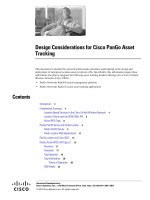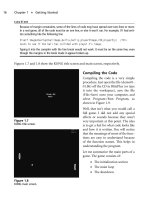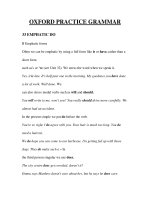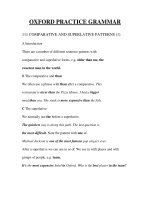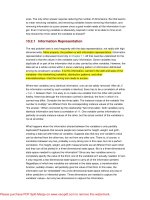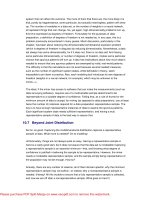Tài liệu Oxford English for Computing pptx
Bạn đang xem bản rút gọn của tài liệu. Xem và tải ngay bản đầy đủ của tài liệu tại đây (12.51 MB, 213 trang )
Oxford English for
Computing
Keith Boeckner
P. Charles Brown
Oxford University Press
Page Page
Unit 1 4 Unit 9 100
Personal computing 4 Computers in education 100
The processor 8 CALL 103
Language focus A
11
Language focus I
108
Contextual reference Giving examples
Unit 2 13 Unit 10 110
Portable computers 13 Computers in medicine 110
Operating systems 20 Data storage and management 115
Language focus
B 24
Language focus J
120
Word formation prefixes Explanations and definitions
Unit 3 28 Unit 11 123
Online services 28 Robotics 123
Data transmission 32 Robot characteristics 128
Language focus C
36
Language focus K
131
Word formation suffixes Compound nouns
Unit 4 39 Unit 12 134
Programming and languages 39 Virtual reality 134
C language 44 VR input devices 139
Language focus D
49
Language focus L
142
Organizing information Classifying
Unit 5 52 Unit
13
145
Computer software 52 Machine translation 145
Comparing software packages 57 Al and expert systems 148
Language focus E
61
Language focus M
152
Making comparisons Cause and effect
Unit 6 66 Unit 14 155
Computer networks 66 Multimedia 155
Network configurations 70 Computer-to-video conversion 160
Language focus F
75
Language focus N
164
Time sequence Making predictions
Unit 7 78 Unit 15 167
Computer viruses 78 Computer graphics 167
Computer security 81 24-bit colour 172
Language focus G
86 Appendix 1 176
Listing Letter writing
Unit 8 88 Appendix 2 197
Computers in the office 88 Glossary of terms
Information systems 94
Language focus H
97
The passive
4
Personal computing
Start-up
Task 1
a
Name these devices. What are they used for?
Listening
Task 2
You will hear two interviews between a market researcher and visitors to a
computer exhibition. As you listen, fill in the missing information in the table
opposite.
Task 4
5
1 mainframe a
2
mouse
b
3
icon
c
4
operating system
d
5
software
e
6
hardware
f
7
microchip
g
Interview 1 Interview 2
Name:
Occupation:
Type of PC used:
Reasons for choice: 1
2
3
Reading
Before reading the text on the following page, match each word with the
correct definition:
the set of software that controls a computer system
a very small piece of silicon carrying a complex
electrical circuit
a big computer system used for large-scale operations
the physical portion of a computer system
a device moved by 'hand to indicate position on the
screen
a visual symbol used in a menu instead of natural
language
data, programs, etc., not forming part of a computer,
but used when operating it.
6
Task 5 Now read the text and decide on a suitable title for it.
n 1952, a major computing
company took a decision to
get out of the business of making
mainframe computers. They
I
5 believed that there was only a
market for four mainframes in the
whole world. That company was
IBM. The following year they
reversed their decision.
1() In 1980, IBM decided that there
was a market for 250,000 PCs, so
they set up a special team to
develop the first IBM PC. It went on
sale in 1981 and set a world-wide
15 standard for IBM-compatibility
which, over the next ten years, was
only seriously challenged by one
other company, Apple Computers.
Since then, over seventy million
20 PCs made by IBM and other
manufacturers have been sold.
Over this period, PCs have become
commodity items. Since IBM made
the design non-proprietary, anyone
25 can make them.
The history of the multi-billion
dollar PC industry has been one of
mistakes. Xerox Corporation
funded the initial research on
30 personal computers in their Palo
Alto laboratory in California.
However, the company failed to
capitalize on this work, and the
ideas that they put together went
35 into the operating system
developed for Apple's computers.
This was a graphical interface:
using a mouse, the user clicks on
icons which represent the function
40 to be performed.
The first IBM PC was developed
using existing available electrical
components. With IBM's badge on
the box it became the standard
45 machine for large corporations to
purchase. When IBM were looking
for an operating system, they went
initially to Digital Research, who
were market leaders in command-
50 based operating systems (these are
operating systems in which the
users type in commands to perform
a function). When the collaboration
between IBM and Digital Research
55 failed, IBM turned to Bill Gates, then
25 years old, to write their
operating system.
Bill Gates founded Microsoft
on the basis of the development
60 of MS/DOS, the initial operating
system for the IBM PC. Digital
Research have continued to
develop their operating system,
DR/DOS, and it is considered by
65 many people to be a better
product than Microsoft's.
However, without an
endorsement from IBM, it has
become a minor player in the
70 market. Novell, the leaders in PC
networking, now own Digital
Research, so things may
change.
The original IBM PC had a
75 minimum of 16K of memory, but
this could be upgraded to 512K if
necessary, and ran with a
processor speed of 4.77MHz. Ten
years later, in 1991, IBM were
so making PCs with 16Mb of
memory, expandable to 64Mb,
running with a processor speed
of 33MHz. The cost of buying the
hardware has come down
85 considerably as the machines
have become commodity items.
Large companies are
considering running major
applications on PCs, something
90 which, ten years ago, no one
would have believed possible of
a PC. In contrast, many
computers in people's homes
are just used to play computer
95 games.
The widespread availability of
computers has in all probability
changed the world for ever. The
microchip technology which
loo made the PC possible has put
chips not only into computers,
but also into washing-machines
and cars. Some books may never
be published in paper form, but
105 may only be made available as
part of public databases.
Networks of computers are
already being used to make
information available on a world-
110 wide scale.
Vocabulary
commodity items (1. 2 3) — items which can be produced and traded freely
non-proprietary (I. 24) — not belonging to any single company
capitalize on (I. 3 3) — profit from, turn to one's advantage
Task 6
When you read the text to decide on a title, which of the following did you do?
Did you:
7
read the text slowly and try to understand every word?
Fl read quickly and try to understand the main theme?
underline or mark sentences that you thought were important?
make notes about important points?
Which of these reading strategies do you think is most appropriate for this kind
of task? Which do you think is least appropriate?
Task 7
Answer these questions about the text.
1 How many mainframes did IBM think it was possible to sell in 1952?
2 How many PCs have now been sold?
3 Who paid for the initial research into PCs?
4 Which company later used the results of this research to develop their
operating system?
5 What are command-based operating systems?
6 DR/DOS is an acronym. What does it stand for?
7 Since the invention of the IBM PC, many of its features have been improved.
Which of the following features does the text
not
mention in this respect?
a memory
b
speed
c size
d
cost
8
Give
three examples from the text of how the availability of computers has 'in
all probability changed the world for ever'.
Task 8
Task 9
Using the line references given, look back in the text and find words that have a
similar meaning to:
1 international (lines 10-15)
2 contested (lines 15-20)
3 errors (lines 25-30)
4 paid for (lines 25-30)
5 buy (lines 45-50)
6 first (lines 60-65)
7 recommendation (lines 65-70)
8 improved (lines 75-80)
Writing
Translate the sixth paragraph (starting 'The original IBM PC...') into your own
language. Look carefully at the tenses before you start.
Task 10
Speaking
The article states that 'many computers in people's homes are just used to play
computer games'.
Discuss the following questions:
1 In what other ways are computers used at home, or outside work?
2 If you already have a PC, how do you use it? (If not, how would you use one?)
Task 11
8
The processor
Reading
Read this passage about the structure of the processor and fill in the gaps using
the words below.
Structure of the processor The
processor consists of a'
which are mounted
2
components linked together by
3
form of control, address, and data
4
, which is a circuit board on
chips, memory chips, and other
lines or channels in the
. In addition, a processor
has , which are electronic circuits providing specialized
functions such as graphics, or which connect a system board to
6 . The system board also consists of electronic devices, such
as an electronic for controlling the speed of operation;
8 , which store numeric data during the course of processing;
and various
9
_, including sequence control register, address
register, and function register.
adaptor boards registers microprocessor
clock conductive buses
system board accumulators input or output devices
Task 12
used to send address details between the memory
and the address register
consists of an arithmetic-logic unit, one or more
working registers to store data being processed, and
accumulators for storing the results of calculations
a group of signal lines used to transmit data in
parallel from one element of a computer to another
groups of bistable devices used to store information
in a computer system for high-speed access
an electronic circuit, usually a quartz crystal, that
generates electronic pulses at fixed time intervals to
control the timing of all operations in the processor
used for storing part of the operating system and
application software known as 'firmware'; can only
be read; cannot be written to or altered in any way
used to store numeric data during processing
a group of signal lines dedicated to the passing of
control signals
used for the temporary storage of application
programs and data; can be written to and read from
9
Reading
Use the information in the reading passage and the diagram to help you match
the terms below with the appropriate explanation or definition.
A processor consists of many different electronic circuits and devices for
performing control functions, arithmetic and logic operations, and data
transfers. Data may be transferred from backing storage to the internal
memory or from the internal memory to the arithmetic unit by means of
5
conductive channels known as buses. The part of the processor which
controls data transfers between the various input and output devices is
called the control unit.
1
microprocessor chip a
2
registers
b
3
accumulators
c
4 control bus d
5
address bus
e
6 data bus f
7
clock
g
8
RAM
h
9
ROM
i
Speaking
Task 13
Work in pairs. Write down the list of terms (1-9) in Task 12 on a piece of
paper. Without referring to your book, take turns to ask and answer questions
about their functions.
1
0
' Useful expressions
What is/are . . .?
What does/do . . . do%
Across
1 A conductive line such as a data bus. (7)
2 A visual symbol used in a menu to represent a file or program. (4)
3 An input device used in computer games. (7)
4 An_____device converts the electrical signals inside a computer into a form
that can exist outside the computer. (6)
S The name given to system software that is held in ROM. (8)
6 A device with one or more buttons used to point at locations on a computer
screen. (5)
7 The part of the CPU that transmits co-ordinating control signals and
commands to the computer. (7,4)
8 1,048,576 bytes. (8)
9 A large store of computerized data. (8)
10 The______system was first used commercially on the Apple Macintosh
computer, but is now widely used on IBM machines. (7)
11 A signal route dedicated to sending information about locations within a
computer. (7,3)
Down
12 A register containing the results of an operation performed by the arithmetic-
logic unit. (11)
10
Exercise 1
11
Language focus A
Contextual reference
Transitional markers are words used to link ideas together so that the text is
easier to read. When pronouns such as it, they, them, I, he, she, which, who, whose, that,
such, one, and demonstrative adjectives such as this, that, these and those, are used as
transitional markers, they refer to a word, or words, mentioned earlier in the
sentence or paragraph. Their function is to take your thoughts back to
something that has already been mentioned. Other words which are often
used to refer backwards are the former, the latter, the first, second, etc., the last.
Using the sample paragraph as a model, draw a rectangle around the word, or
words, that the circled words refer to. Then join the CD and the =with arrows.
12
Exercise 2
Using the line reference given, look back at the reading passage in Unit 1,
page 6, and find the reference for the words in italics.
1 anyone can make them (line 25)
2 the ideas that they put (line 34)
3 This was a graphical interface (line 37)
4 it became the standard machine (line 44)
5 these are operating systems (line 50)
6 it has become a minor player (line 68)
7 this could be upgraded (line 76)
13
Portable computers
`This is the smallest, most powerful computer in the world.'
`Those? Those are the batteries.'
Start-up
Task 1
Discuss the following questions:
1 How small do you think computers can usefully become?
2
To what extent does the size of a computer influence what it can be used for?
Think of examples to illustrate your answer.
14
Listening
Task 2 Listen to the following extract from a radio talk show called Computerworks in
which the host talks with Sandra Cavanah, a writer with a computer
magazine. As you listen, fill in the missing information about the various
portable computers.
Portable
Power:
Weight:
Screen size:
Inplnputvice:
runs on
between 15 and
about ten inches diagonally
keyboard
pounds
Notebook
Power: batteries
Weight: as little as
Screen size: as small as _
Input device: keyboard
pounds
inches
15
Reading
Task 3 Before reading the text, match these words with their definitions:
a clipboard
b stylus
c screen
d grid
e voltage
f pixel
g template
1 surface on which pictures or data are shown
2 electrical force
3 pattern used as a guide for creating letters or characters
4 individual dot on a computer screen
5 network of lines crossing at right angles
6 pointed implement for drawing or writing
7 portable board with a clip at the top for holding papers
Task 4 Read the text and decide why the author chose the title Delete Keys. Can you
suggest a better title?
Delete Keys - Clipboard Technology
O R T H E L A ST G EN ER A T I O N,
Silicon Valley and Tokyo haveF
been working to design computers
that are ever easier to use. There is
5 one thing, however, that has
prevented the machines from
becoming their user-friendliest: you
still have to input data with a
keyboard, and that can require you
10 to do a lot of typing and to
memorize a lot of elaborate
commands.
Enter the clipboard computer, a
technology that has been in
15 development for the last 20 years
but took hold in the mass market
only this year. Clipboard PCs —
which, as their name suggests, are
not much bigger than an actual
20 clipboard — replace the keyboard
with a liquid crystal display (LCD)
screen and an electronic stylus.
Users input data by printing
individual letters directly on the
25 screen.
There are two technologies at
work in a clipboard PC: one allows
raw data to get into the computer
and the other allows the computer
30 to figure out what that data means.
The first technology relies
principally on hardware and varies
depending on the particular
computer. In one system, marketed
35 under the name GRIDPad, the
computer's LCD screen is covered by
a sheet of glass with a transparent
conductive coating. Voltage is sent
across the glass in horizontal and
40 vertical lines forming a fine grid;
at any point on the grid, the
voltage is slightly different.
When the stylus — which is
essentially a voltmeter — touches
45 the screen, it informs the
computer of the voltage at that
point. The computer uses this
information to determine where
the stylus is and causes a liquid
so crystal pixel to appear at those
coordinates. The position of the
stylus is monitored several
hundred times a second, so as
the stylus moves across the glass,
55 whole strings of pixels are
activated.
`What we do is sort of connect
the dots,' says Jeff Hawkins, the
creator of GRIDPad. 'Users can
60 then write whatever they want
on the screen with a kind of
electronic ink.'
Making that writing
comprehensible to the computer,
65 however, requires the help of
some powerful software. When
the stylus is being used, the
computer is programmed to look
for moments when the tip does
70 not touch the screen for a third
of a second or more. Every time
this happens — and it happens a
lot when somebody is printing —
the software assumes that one
75 letter or number has been
written. The pixel positions of 1
0
.-
1
Task 5
16
1
41 this fresh character are then passed
on to the computer's pattern
recognition software, which
so instantly identifies the letter or
number written.
The software does this by first
cleaning up the character —
smoothing out crooked lines and
85 removing errant dots. The
remaining lines and curves are then
compared with a series of templates
in the computer's memory that
represent hundreds of thousands of
90 different versions of every letter in
the English alphabet and all ten
numerals. When the computer finds
the closest match, it encodes the
character in memory and displays it
95 on the screen as if it had been typed.
The entire process takes just a
fraction of a second. To delete a
word, you simply draw a line
through it. To move to the next
too page, you flick the stylus at the
bottom of the screen as if you're
flicking the page of a book.
There are a handful of clipboard
computers now on the market,
105 including GRIDPad, which is sold in
the US; Penvision, manufactured by
NCR and sold around the world;
and Sony's Palmtop and Canon's
Al Note, both sold only in Japan.
1() IBM and Apple are also pouring
millions of dollars into the
technology.
In addition to this hardware, a
variety of software is also
115 making its way to the market.
Depending on the power of the
computer and the sophistication
of the software, clipboard
systems can be programmed to
120 understand the particular quirks
of a particular user's printing;
this is an especially useful
feature in Japan, where
elaborate kanji characters make
125 up most of the written language.
Improvements in software may
soon allow machines sold in the
US to understand not only
printing but continuous script as
130 well.
Given such flexibility, the
designers of clipboard computers
are predicting big things — and a
big market — for their products.
135 'There's no doubt about it,' says
an optimistic Hawkins. 'You're
going to own one of these things
in the not-too-distant future.'
■
►
Vocabulary
printing (1. 73) — (in this case) writing separated letters or numbers by hand
kanji (1. 124) — Japanese script which uses Chinese characters
Decide whether the following statements are true (T) or false (F) in relation to
the information in the text. lf you think a statement is false, change it to make
it true.
The Americans and the Japanese are working together to produce user-
friendlier computers.
The clipboard computer was first sold twenty years ago.
On a clipboard, an electronic pen replaces the traditional keyboard.
ln the GRlDPad system, when the pen touches the screen, it informs the
computer and a liquid crystal pixel appears at that point.
The software decides that one character or number is complete if the tip of
the stylus is not in contact with the screen for more than half a second.
The whole process of recognizing letters or numbers and printing them on
the screen takes very little time.
There are many clipboard computers sold today which are all available
everywhere in the world.
Clipboard systems can be made to understand any kind of writing.
17
Task 7
Using the line reference given, look back in the text and find the reference for
the words in italics.
1 from becoming their user-friendliest (line 7)
2 one allows raw data to get (line 27)
3 it informs the computer (line 45)
4 Every time this happens (line 72)
5 which instantly identifies (line 79)
6 it encodes the character in memory (line 93)
7 this is an especially (line 122)
8 for their products (line 134)
Task 8
Using the line references given, look back in the text and find words or phrases
that have a similar meaning to:
1 understand (lines 2 5-30)
2 sold (lines 30-35)
3 covering (lines 35-40)
4 points (lines 50-55)
5 join (lines 55-60)
6 making even (lines 80-85)
7 not straight (lines 80-85)
8 made by mistake (lines 85-90)
9 move quickly and sharply (lines 95-100)
10 unique features (lines 115-120)
18
Task 9
Choose the correct word to complete each sentence. You may have to change
some words slightly. •
1 electron, electronic, electronics, electronically
a An pen is o ne ex amp l e o f a n i np ut d evi ce.
b A computer solves problems
c
Many ___________students go on to work as engineers.
2 technology, technological, technologically, technologist
a The computer is the greatest ____________invention of the twentieth
century.
b There are two __________involved in a clipboard PC.
c
Today's computers are far superior to those used a few years
ago.
3
identify, identifying, identifiable, identity
a The clipboard's pattern recognition software immediately
the letters and numbers written by the stylus.
b Most computer companies will not allow people without an
card to enter their premises.
c A password is a mechanism for_____________the computer-user and
allowing access.
4 compute, computing, computation, computerize, computerization
a The of the manufacturing division will be expensive in the
short term, but cost-effective in the long term.
b We should be able to___________________
with the new program.
c I could tell from all the
in progress.
___our profit for next year fairly accurately
on the board that a maths lesson was
Writing
Tas 10
Translate the third paragraph (starting 'There are two technologies...' ) into
your language. Check the meaning of any unfamiliar technical words in the
glossary at the back of this book.
Speaking
Task 11 Discuss the following questions:
1 What are the limitations of portable computers?
2 Do you think students should be allowed to use portable computers in class?
Task 12
19
Writing
Write an advertisement for a real or imaginary notebook computer. Your
material should include its name and type, its size, price, and capacity, and the
features that make it superior to other models.
You may base your material on the advertisement above, but do not copy
straight from the text.
20
Speaking
Task 13 Work in pairs.
Student A: You are a sales representative trying to sell your company's
notebook computer. You are presenting your product to the Sales Director of a
manufacturing company which is thinking of buying 30 notebook computers
for the sales staff. Decide on the specifications and complete the table below.
Then try to persuade the Sales Director to buy your product.
Name
Type (size)
Processor type
Operating speed
Memory
Display
Power supply
Cost
Other features
4Useful expressions
It
costs...
It runs/operates on... It
weighs...
Student B: You are the Sales Director of a manufacturing company. You are
considering buying 30 notebook computers for your sales staff. Find out about
all the specifications of the model on offer. Decide whether it is suitable for your
needs.
4Useful expressions
How much does it cost?
What power source does it use? How
big/heavy is it?
Operating systems
Reading
Task 14 Before you read the text, try to answer the following questions:
1 What is an operating system and what is its purpose?
2 Where is an operating system stored and how is it transferred to internal
memory?
3 List some of the tasks typically performed by an operating system.
Now read the text and check your answers.
21
General features of operating systems
An operating system is a master control program which controls the
functions of the computer system as a whole and the running of
application programs. All computers do not use the same operating
systems. It is therefore important to assess the operating system used on a
5 particular model before initial commitment because some software is only
designed to run under the control of specific operating systems. Some
operating systems are adopted as 'industry standards' and these are the
ones which should be evaluated because they normally have a good
software base. The reason for this is that software houses are willing to
1() expand resources on the development of application packages for
machines functioning under the control of an operating system which is
widely used. The cost of software is likely to be lower in such
circumstances as the development costs are spread over a greater number
of users, both actual and potential.
15 Mainframe computers usually process several application programs
concurrently, switching from one to the other, for the purpose of
increasing processing productivity. This is known as multiprogramming
(multi-tasking in the context of microcomputers), which requires a
powerful operating system incorporating work scheduling facilities to
20 control the switching between programs. This entails reading in data for
one program while the processor is performing computations on another
and printing out results on yet another.
In multi-user environments an operating system is required to control
terminal operations on a shared access basis as only one user can access
25 the system at any moment of time. The operating system allocates control
to each terminal in turn. Such systems also require a system for record
locking and unlocking, to prevent one user attempting to read a record
whilst another user is updating it, for instance. The first user is allocated
control to write to a record (or file in some instances) and other users are
30 denied access until the record is updated and unlocked.
Some environments operate in concurrent batch and real-time mode. This
means that a 'background' job deals with routine batch processing whilst
the 'foreground' job deals with real-time operations such as airline seat
reservations, on-line booking of hotel accommodation, or control of
35 warehouse stocks, etc. The real-time operation has priority, and the
operating system interrupts batch processing operations to deal with real-
time enquiries or file updates. The stage of batch processing attained at the
time of the interrupt is temporarily transferred to backing storage. After
the real-time operation has been dealt with, the interrupted program is
40 transferred back to internal memory from backing storage, and processing
recommences from a 'restart' point. The operating system also copies to
disk backing storage the state of the real-time system every few minutes
(periodic check points) to provide a means of 'recovering' the system in the
event of a malfunction.
45 An operating system is stored on disk and has to be booted into the
internal memory (RAM) where it must reside throughout processing so
that commands are instantly available. The operating system commands
may exceed the internal memory capacity of the computer in which case
only that portion of the OS which is frequently used is retained internally,
50 other modules being read in from disk as required. Many microcomputers
function under the control of a disk operating system known as DOS.
22
Task 15
Answer these questions about the text.
1 Why is it important to assess the operating system on a computer before
buying it?
2 What is multiprogramming?
3 The text gives some examples of real-time processing. Can you think of some
examples of batch-processing?
Task 16
Here is a list of typical tasks performed by an operating system. In each case the
main verb has been omitted. Fill in the blanks from the words given. Sometimes
more than one may apply.
A typical operating system will:
1 input and output devices.
2 the status of hardware devices.
3 hardware interrupts.
4 new disks.
5 disk directories.
6 _ disk reading and writing operations.
7 d i s k e r r o r s .
8 disk commands relating to the deletion, copying,
renaming, and dumping of files.
execute
monitor
format
diagnose
Task 17
Match these common DOS commands with the appropriate explanation.
1
BACKUP
a
2
CHDIR or CD
b
3
CHKDSK
c
4
CLS
d
5 DEL
e
6
DIR:SORT
f
7
REN
g
8
TYPE
h
9 FIND i
10 DISKCOPY
j
searches for a specific string of text in a file.
allows a text file from the current directory to be
displayed on screen.
allows the user to change the name of a file.
saves the contents of the hard disk to a floppy disk for
security purposes.
is used when it is necessary to change the current
directory.
clears data from the screen.
alphabetically sors and lists a disk directory.
makes back-up copies of the contents of one disk to
another.
deletes a specified file from the current directory,
specified drive, or specified path.
produces a status report of the currently logged-on
disk, indicating the amount of disk space used, the
available capacity (in bytes), and the number of files
on disk.
23
Word-play
Task 18
Find the hidden words in this square. Some appear vertically, some
horizontally, and some diagonally. They may be upside-down or back to front.
Use the clues below to help you. The number of letters in each word and the
first letter of the word appear in brackets after the clue. The first one has been
done for you.
Find words which mean:
1 a computer that is small enough to hold in the hand. (7, P)
2 an electronic pen. (6, S)
3 to erase or omit. (6, D)
4 one type of portable computer which operates with an electronic pen. (9, C)
5 the information that the computer processes. (4, D)
6 a network of lines crossing at right angles. (4, G)
7 a signal to a processor to suspend temporarily the current sequence of
instructions. (9, I)
8 a pattern used as a guide for creating letters or characters. (8, T)
9 an individual dot on a computer screen. (5, P)
24
Language focus B
Word formation: prefixes
When you are reading, you will come across unfamiliar words. lt is often
possible to guess the meanings of these words if you understand the way words
in English are generally formed.
An English word can be divided into three parts: a prefix, a stem, and a suffix.
Pre-means 'before'. A prefix, therefore, is what comes before the stem. Consider,
as an example, the prefix de- (meaning 'reduce' or 'reverse') in a word like
demagnetize (meaning 'to deprive of magnetism'). A suffix is what is attached
to the end of the stem. Consider, as an example, the suffix -er (meaning
`someone who') in programmer Ca person who programs').
Suffixes change the word from one part of speech to another. For example, -ly
added to the adjective quick gives the adverb quickly. Prefixes, on the other
hand, usually change the meaning of the word. For example, un- changes a
word to the negative. Unmagnetizable means 'not capable of being
magnetized'.
Let us now consider some prefixes, their usual meanings, and how they change
the meanings of English words.
Prefixes
Negative
and positive
Size Location
Time and
order
Number
un- semi- inter- pre- mono-
non- mini- super- ante- bi-
in- micro- trans- fore- hex-
dis- ex- post- oct-
re- extra-
peri-
multi-
25
Exercise 1 Study these tables. Try to find additional examples, using your dictionary if
necessary.
1 Negative and positive prefixes:
semi- half, partly semiconductor
equi- equal equidistant
mini- small minicomputer
micro- very small microcomputer
m a c r o -
l a r g e , g r e a t 1 macroeconomics
mega- megabyte
